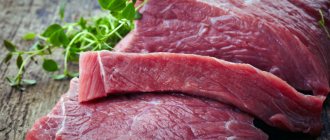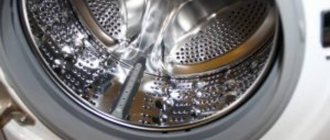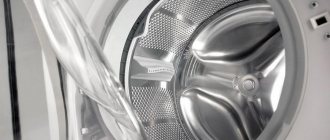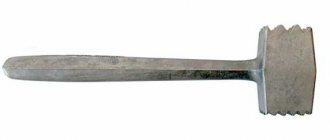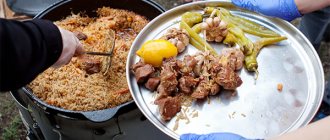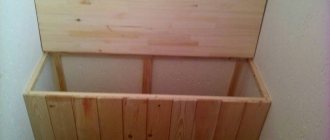Many people are interested how to pound meat correctly. When you hear the word “chop,” your imagination immediately conjures up juicy pork chops, lamb chops on the bone, Wiener schnitzel, krucheniki, steak, escalope, beef stroganoff, Kiev cutlets, chicken chops and rolls, meat rolls with prunes or mushrooms. To prepare all these dishes, we need a meat hammer, which is probably found in every kitchen.
The meat is beaten in order to separate and soften the muscle fibers so that the meat remains soft when cooked. Beating also gives a piece of meat a larger area, so that it is convenient to make rolls.
You can beat meat from various parts of the meat carcass. To prepare classic chops, a loin is used (with or without the bone), you can also beat the flesh of the neck or hind leg (ham), and a shoulder (mostly pork) is used somewhat less frequently.
What is a tenderizer and what is it for?
There are various cooking methods for meat and a large number of recipes for dishes made from this product. The choice of meat, marinade, and cooking method is everyone’s business. But there is a device that will be useful in the kitchen of all cooks - this is a tenderizer. It will help make the meat juicy and tender.
How can you beat meat without a hammer?
There are times when you don’t have a kitchen hammer at hand. In such situations, there is no need to immediately abandon the idea of cooking chops. Many people do not know how to beat meat without a special hammer and cannot even imagine that ordinary household utensils can help with this.
For example, an ordinary knife with a thick blade can be an excellent replacement for a kitchen hammer. It is very easy to make chops with this device. Slices of meat must be struck with the blunt side of the knife. Many chefs do not recognize kitchen hammers and beat the product this way.
Here's another life hack on how to beat meat without a hammer. An ordinary glass bottle can replace a kitchen hammer. You can use it to make a soft and juicy dish by tapping it with the neck of a bottle turned upside down.
A puree maker and a dough rolling pin are also good helpers. With their help you can loosen the meat quite quickly.
If you don’t have a kitchen hammer at hand, but suddenly find yourself with an ordinary hammer, then it can also become an assistant in preparing chops. To do this, you need to tape a regular fork to it with tape or tape and beat it with this side. Excellent replacement.
As you can see, the question of how to beat meat without a hammer is not so difficult. There are different methods, and every housewife can find one that she likes.
What is a tenderizer
Meat tenderizer is a device used for tenderizing meat. It has several types of design, but the essence of their action remains the same - knives (spikes, needles) come out of the body, which pierce the product. The length of the knives is 1-2 cm.
What is a tenderizer for, and how effective is its use? Its effect disrupts the connection between meat fibers. Its structure becomes more delicate, the process of preparation and marinating is reduced. A processed steak requires less cooking time, the quality of heat treatment is improved, and the taste is improved. Processing can improve the taste of even middle-aged meat.
With its help, in your home kitchen you can prepare a dish that is not inferior in taste, tenderness and juiciness to restaurant masterpieces from chefs.
How to use the tenderizer
Meat tenderizers can be of several types:
Hand-held devices are compact and can have different shapes - round, square, rectangular.
When pressed, the knives move out of the body and pierce the fibers. The process looks like this step by step:
- a piece of meat is placed on a cutting board;
- a base is installed on top;
- press the handle once or twice;
- the base is moved to another area and the action is repeated.
Advantages of the tenderizer
Can a tenderizer be compared to a hammer? The purpose of these two kitchen appliances is really the same - to soften hard fibers, but the effectiveness is different. The tenderizer has a number of advantages:
- The work is not accompanied by strong noise, characteristic when using a hammer for beating.
- The piece retains its shape.
- The product does not lose its juiciness, since the blades make very thin punctures that immediately close. All the juice remains inside.
- The meat pounding device allows you to minimize contamination of the cutting surface and the area around it.
- Models with a marinade or sauce reservoir allow you to soften and marinate at the same time.
An additional advantage is ease of use and safety. Due to the comfortable handle, manual models are easy to use.
The main disadvantages of pounded meat
When beating meat, valuable components in the form of proteins and fats are preserved, but there are also some that can be lost.
During the process of beating meat, a large amount of juice and liquid is released. This juice contains, although replaceable, useful substances - mineral salts, vitamins and other biologically active substances.
And it’s clear that the harder the beating is done, the more liquid is released. The optimal solution would be to find a degree of tenderization that preserves the maximum possible amount of nutrients while maintaining a fairly soft meat consistency.
How to choose a tenderizer
To make the device a real assistant in the kitchen, choose the right model. The following parameters are taken into account.
- Type of device - manual, mechanical or electric. The choice depends on the desired performance and frequency of use.
- Design. Choose a model with maximum protection. This will prevent injury.
- Ease of use. A manual model should be relatively lightweight and provide comfortable work.
- Dimensions - ease of use and storage depends on them.
Recommendations for use
One of the characteristics of the device is the presence of sharp elements. When operating, pay attention to safety. Most models have a protective cover on the body that reliably hides the knives and prevents accidental contact with your hands. The exception is roller models. Special care must be taken when using them.
When processing the product, hold it with a fork or spatula. But in no case with your hand.
Areas containing bone are carefully treated. They should be avoided. Knives may break if they come into contact with hard elements.
Cleaning of the device is carried out according to the manufacturer's instructions. Removable parts are washed with hot water. All elements are thoroughly dried, then assembly is carried out. It is not recommended to wash the parts in the dishwasher, because... they may become dull.
Kitchen hammer or tenderizer - which is the best meat tenderizer?
Whether you are cooking steak, kebabs, chicken, roasts or chops, the meat must be tender and juicy. A special softener will help soften hard pieces that will be easy to chew and simply melt in your mouth. The kitchen gadget breaks or loosens tight protein bonds, allowing the marinade to penetrate deeply into the meat, enhancing its flavor. It cooks faster and becomes incredibly soft. But which one should you choose?
A classic kitchen hammer, which we used to beat meat into chops, or a tenderizer with steel needles? The Constant Sales Store has carefully studied both tools and is ready to share its findings.
How to properly fry and bake meat
How to properly process meat before frying? In particular, does it need to be washed? It's better not to wash the meat. However, if there are bone crumbs left on the piece, then, of course, the meat should be rinsed and then dried well with a waffle or paper towel. The meat must be dry before frying.
What weight and thickness should a piece of meat be to make the perfect steak? A good steak should weigh 300-400 grams and have a thickness of at least 2.5 cm. Only in this case will you be able to get the doneness you need.
Does the temperature of the meat before frying play a role? Steaks should be at room temperature before frying.
What is the best way to fry a steak and what to use to make the meat juicy? To cook a juicy steak, two parameters are important - temperature and time.
It is best to cook steak over an open fire. If this is not possible, then in a frying pan with a thick bottom and a grooved surface. A thick bottom is necessary so that the pan, once heated, maintains a high temperature. Otherwise, a piece of raw meat will cool the pan and, when it warms up again, it will cook rather than fry the meat. A grooved frying pan or grill pan cooks meat better than a regular frying pan. In such a frying pan, the meat does not stick to the surface. And the grooved bottom lifts the meat above the oil or juices in the grooves, preventing the steak from drying out.
And how do you know that the pan is hot enough to fry? There are two ways to determine whether the pan is warm enough for frying. First, add a drop of water. If the pan is heated to the desired temperature, the water will instantly evaporate. Secondly, pour vegetable oil into the frying pan. When the temperature required for frying is reached, it will begin to smoke quite a bit.
What about time? It all depends on the size of the steak, the chosen cooking method and the degree of frying you need.
On an open fire - grill, meat, of course, cooks faster than in a frying pan. The juiciness of the meat depends on the degree of roasting. The fattier the meat, the higher the degree of roasting it requires. For example, it is better to fry ribeye to at least medium. When the meat is well fried outside and inside, the depth of frying is deep, and the meat when cut is pink, slightly damp and exudes pinkish juice. But filet mignon will be juicier when cooked less - medium rare, when the outer part of the steak is cooked through, and if you cut it, the blood comes out.
And if the meat turned out a little dry, where was the mistake? Apparently, the wrong cooking method was chosen for this piece of meat. There are pieces that are best boiled, and there are those that need to be fried. I repeat that it is very important to choose not only good meat, but also to choose the right cooking method for each specific cut.
Another controversial issue is when to salt and pepper meat? Before or after frying? Not important. The main thing is not to do this in advance, as the salt will draw out all the moisture from the meat, and the steak will turn out dry and tough. In restaurants in Spain, for example, steaks are often not salted at all, and salt is served separately with the meat.
Is it necessary to pound the meat? Are there any rules when it is necessary to beat meat and why is it done? Beef steaks are never pre-beaten. Pork and veal schnitzels are usually beaten to better soften the fibers and for faster frying.
How to achieve a crispy crust while frying? High temperature when frying - first of all. Only at high temperatures does the process of caramelization of sugars contained in meat occur. You can enhance it by brushing a piece of meat with a little simple sugar syrup or some other sugar-containing sauce. For example, barbecue or teriyaki, as is often done when roasting meat in a whole piece. The main thing is to know when to stop.
What oil is best to fry meat in? In my opinion, it is best to use refined vegetable oil for frying. Often when frying a steak, when it is almost ready, a small piece of melted butter is placed on the meat - to make the crust softer, in addition, this gives the meat a delicate creamy taste.
We seem to have sorted out the steaks. Now there are many questions with roasting meat in a whole piece. At what temperature should I bake it to get a crispy crust? Should it be changed during baking? How to determine the readiness of meat? It is believed that you need to start baking meat at a high temperature, more than 200°C, then lower it.
I am an opponent of this dogma and believe that you need to start with a temperature of 150-160°C. When the meat is almost ready, you should raise the temperature in the oven to 200°C or higher. It is in this case that the crust on the meat will be ideal. You can calculate the baking time approximately according to the following scheme: to bake 1 kg of beef it will take 40-50 minutes. Immediately after you have baked the meat, you should not eat it. Remove the meat from the oven and let it stand for 20 minutes at room temperature. During this time, the juices will be evenly distributed inside the piece and, by the way, it will be easier to cut such meat. The easiest way to determine whether meat is done is to use a temperature probe. For lamb and beef, the temperature inside the piece should be no more than 58°C. Otherwise the meat will be dry. For pork and chicken, the meat of which cannot be eaten uncooked, the temperature must be above 71°C.
Meat and potatoes are a familiar combination. Which side dish do you personally prefer? The steak is self-sufficient and can be eaten without a side dish. But if a side dish is necessary, I would recommend a simple green salad. Grilled meat also goes well with asparagus and other grilled vegetables.
How to choose meat Kirill Martynenko tells how to choose, store and prepare meat for cooking. See more...
Why do you need a meat tenderizer?
A meat mallet or tenderizer is essential for tenderizing tough cuts of meat. Tender chops and steaks cook faster—you can reduce grilling time by up to 50%. The tender meat has loose fibers, so it has enough holes for quick heating and even cooking. Plus, you save resources because when food cooks faster, less gas or electricity is consumed.
Best Kitchen Meat Hammer: Review and Buying Guide
A hammer is a traditional tool for cooking pork, beef and chicken chops. It has two working sides: a pyramid-shaped surface that effectively breaks down strong muscle fibers and a flat, smooth surface to smooth out meat so it cooks evenly. Easy and simple to use: just pick a side and hit the piece with it.
You can buy a hammer for beating meat from different materials:
Wooden gadgets
can be made entirely of wood or equipped with metal plates, which are excellent for processing chicken fillets and tender pieces without cartilage and bones. In this case, it is important to avoid contact of natural wood with raw food to prevent the growth of bacteria. Plastic film will help solve the problem. After each cleaning, dry the kitchen gadget thoroughly to avoid the development of mold.
Some tips on how to beat meat
- For beating, fresh meat that has not been frozen is best suited (such meat will be juicier, since it will not lose juice when defrosted) or completely thawed meat: frozen meat contains frozen water, and when beating it will simply tear into pieces. Therefore, first leave the frozen meat to defrost so that as much water as possible can drain out of it. The meat must be young, not stringy and not too lean.
- If you rinse the meat, be sure to dry it before frying so that the chops do not turn out dry.
- Do not salt or pepper the meat before beating; it is better to salt the meat during frying, when a crust forms, or immediately before it. If you salt the meat long before frying, it will release juice and lose tenderness. If you cook meat in batter or sauce, salt the batter or sauce itself, so the spices will only emphasize the taste of juicy meat.
- When beating the meat, wrap it in cling film. This is very convenient to avoid splashes and keep the walls and table clean. This way you can very carefully beat off even chicken or turkey hearts or liver.
- Beat the meat evenly on both sides, paying special attention to the edges. When frying, the fibers contract, and evenly pounded meat will increase in thickness equally.
- Larger teeth of a hammer are used if a thick piece of meat needs to be beaten thinner, or if it is a bit tough. Small teeth are convenient for beating off the edges of meat. This is done so that the chops do not shrink or become deformed when frying.
- You need to beat the meat carefully to make it soft, but not to put holes in it.
- Do not pound the meat too thin, otherwise it will become too dry after frying.
- To get delicious chops, you need to fry them in a very hot frying pan. In 2-3 minutes. The meat should be covered with a golden brown crust, which will prevent the juice from flowing out.
- To avoid making noise throughout the house, place a kitchen towel under the cutting board.
How to beat meat without a hammer
If you don't have a hammer at hand, you can beat the meat with a rolling pin or the handle of a knife. A potato masher will also work. Another option is to beat the meat with the bottom or neck of a bottle.
Meat tenderizer: characteristics, reviews
Every housewife is more or less familiar with the problem of processing meat products. As you know, in order for a meat dish to turn out tasty, tender and juicy, it must first be soaked in marinade, saturated with its aroma and moisture. Simply putting a piece in a pickling composition is not an option: the soaking process will be unbearably long; Cutting into pieces is also not always possible (for example, if the recipe calls for a whole piece). For many years, to speed up this process, cooks and housewives used a special hammer to beat meat. It softened the fibers, making the meat more pliable for subsequent processing. However, this method has one big drawback: meat that is too tender (for example, chicken fillet) often breaks during such intense exposure, especially thin edges turn into torn scraps.
How to beat chicken fillet
To prepare some dishes (for example, chops, Kiev cutlets or rolls), we need beaten chicken fillet. This task may seem simple at first glance, but a novice cook can, due to inexperience, beat tender chicken meat to holes. Look at step-by-step photos on how to beat chicken meat.
To make a thin slice, make a cut and unfold the chicken breast in the shape of a heart.
It is better to beat chicken meat with a wooden mallet, not a metal one, and better on the side so that there are no cuts that easily damage the tender chicken meat. If you use a hammer with metal notches, beat the fillet carefully so that it remains intact.
The beaten meat can be breaded or filled with filling and rolled up.
“Our Recipe” wishes you a good mood and delicious dishes!
A worthy substitute for the usual hammer for beating
Fortunately, the problem of meat being damaged by rough beatings was solved when the meat tenderizer was created. Its name comes from the English word meaning “gentle.” This is a special device that is equipped with many miniature, very sharp knives. With a few presses of this machine, you can prepare even a large steak for subsequent cooking in a matter of seconds, making its structure, as expected, more tender. The length of its knives is on average 1-2 centimeters, which in most cases is more than enough for full penetration of the pickling composition.
The main advantage of this seemingly simple but cunning device is that the process of preparing a meat dish using a meat tenderizer is reduced by almost half. This amazing difference is not only the result of accelerated primary processing of the meat product. The fact is that softened and loosened meat passed through a tenderizer is also fried more quickly and, most importantly, evenly. And its taste turns out to be much more multifaceted and richer.
Not a bad result, isn't it? It is especially noticeable in professional kitchens: in cafes and restaurants, when not only the quality of food, but also the speed of the cooks must be at their best. There are many visitors who are willing to wait an extra half hour in order to receive a juicy, richly flavored, aromatic dish. However, none of them will still be happy about this prospect. The electric version of the tenderizer can further simplify and speed up cooking. But due to its cost, only establishments with a stable flow of visitors, where, without exaggeration, every minute is important, allow themselves such luxury. Thus, the meat tenderizer more than deserves its reviews, written by satisfied and grateful owners of the device.
Benefits of pounding meat
Due to the fact that the structure of the meat is softened by beating, such a product is easier for the body to process. Meat fats and proteins in the intestines will be absorbed much faster and completely, and much less meat that can rot will reach subsequent sections.
One of the serious causes of diseases of the intestinal tract is the deposition and decay of proteins in it. This is what vegetarians are guided by when they talk about the dangers of eating meat. Due to this rotting process, poisoning, flatulence, various disorders, and even rectal cancer can develop.
And when eating pounded meat, this risk of protein deposition and rotting is minimized. Not to mention the teeth and the damage that rough meat can cause them.
However, in addition to the advantages, there are also disadvantages.
Cleaning the device: simple and fast
The meat tenderizer tenderizer has a collapsible mechanism that can be manually expanded down to the smallest elements. Thanks to this, washing it is greatly simplified: there is no need to dodge and remove pieces of meat stuck somewhere, risking injuring your hands on the sharpest knives. Thus, the professional tenderizer ensures maximum safety during operation. The likelihood of injury is reduced to zero. This, by the way, also speeds up the work with it, since the cook working with meat does not fear that a frightening-looking electric monster can cut off his arms up to the elbows.
Electric meat tenderizer
Such a machine consists of three main parts:
- housings;
- electric drive;
- working body.
The drive is also divided into several components: an electric motor and a gearbox. The knives begin to move due to the action of a cylindrical pair and, rotating, move towards. Thus, the result is meat that is evenly processed on both sides at once. To soften meat in the tenderizer, place it in the receiving hole. There it is automatically captured by the blades and quickly processed. You can also soften pieces of meat connected to each other. To do this, you should place one piece on top of another, place them in the device, and turn the meat 90 degrees while passing it again.
Review of interesting kitchen hammers
What is attractive about this model is its unusual shape, which dictates non-standard use. A metal kitchen hammer for beating meat in the form of brass knuckles is more popular with men who combine cooking with training.
The disadvantage of culinary brass knuckles is that one working surface is usually corrugated. And be careful when ordering an unusual device from foreign online stores. It may be incorrectly assessed at customs, mistaking it not for kitchen utensils, but for an item prohibited for purchase.
If you are not only tenderizing, but also chopping meat, look for a hammer with a hatchet. A hatchet hammer will help you deal with chicken bones and hard pieces without resorting to a knife. The size of the blade depends on your culinary tasks and needs. If you are chopping pork carcasses, such an accessory will be useless. It's better to buy a separate hatchet.
A tenderizer hammer is easily recognized by the long, sharp needles or thin blades on one side of the working part. The other side is made with reliefs or smooth to level the chop.
The tenderizer does not beat, but silently and effortlessly pierces a piece of meat through and through, without tearing or flattening it. The marinade and spices penetrate deeply into the holes of the loose cutlet. Can be used as an alternative to a chipper for faster and less difficult processing.
If you know which meat hammer is best to choose, share your experience in the comments. Your tips will help novice housewives make the right purchase.
Safety and operating features
Using a meat tenderizer in production, you don’t have to worry about safety precautions. No, it is definitely necessary to know it. But the fact is that the operator has no chance of getting injured while working with it. As soon as the protective cover moves from its usual position by even a millimeter, a special function is triggered and the engine stops automatically.
As for maintenance, the meat tenderizer can be easily disassembled into stationary and removable parts that can be washed. However, in order to extend the service life of the machine, it is necessary to periodically lubricate the auger and the gear transmission of the rotation mechanism with oil. Sharpening knives can be done mechanically or manually, using a file or whetstone. The first method requires maintenance in a workshop.
Advantages of electric models
Despite the impressive performance, the dimensions of the tenderizer are very small. However, based on how the meat tenderizer is characterized by reviews about it, the following conclusions can be drawn:
- The tenderizer is a significant reduction in cooking time.
- It makes it easy to keep your workplace tidy and clean.
- Meat is less injured during processing, but is processed better.
- Its heat treatment is also significantly accelerated.
- Second grade meat is loosened no less effectively than more tender meat.
- The device allows you to knock down individual pieces of meat, resulting in whole steaks.
- Thanks to the variety of attachments, you can get meat cut into the desired shape.
The cost of this device varies depending on a lot of factors such as power, dimensions, performance and, of course, brand name. It makes no sense to take both the most expensive and the most budget device. It is better to read reviews about specific models and, based on them, buy a tenderizer that not only most closely meets the needs of its owner, but also one that will serve for many years without changing the quality of product processing. Regardless of whether it is manual or electric, such a purchase will be extremely practical even in a small home kitchen. And working with him is not only fast, but also pleasant.
